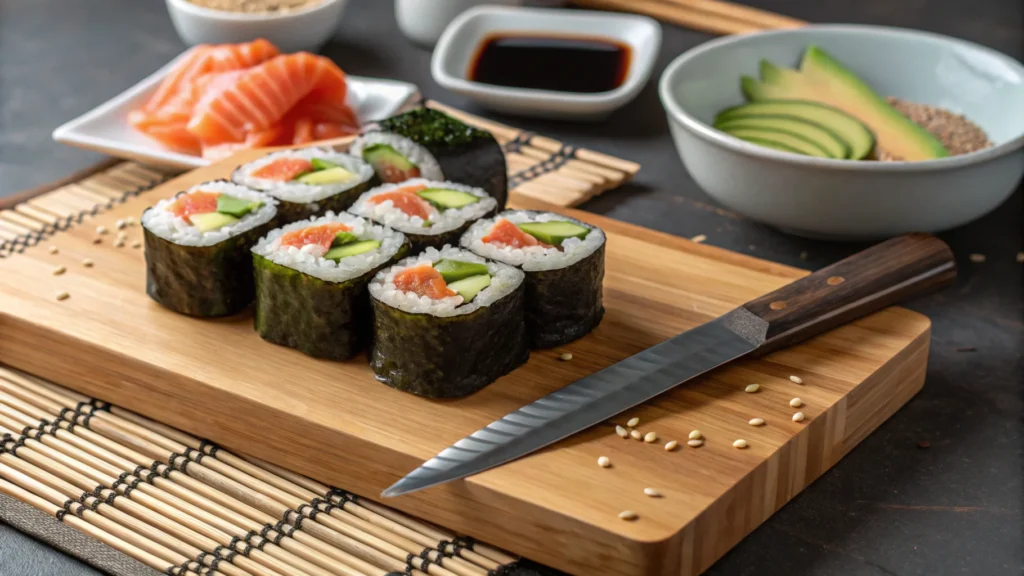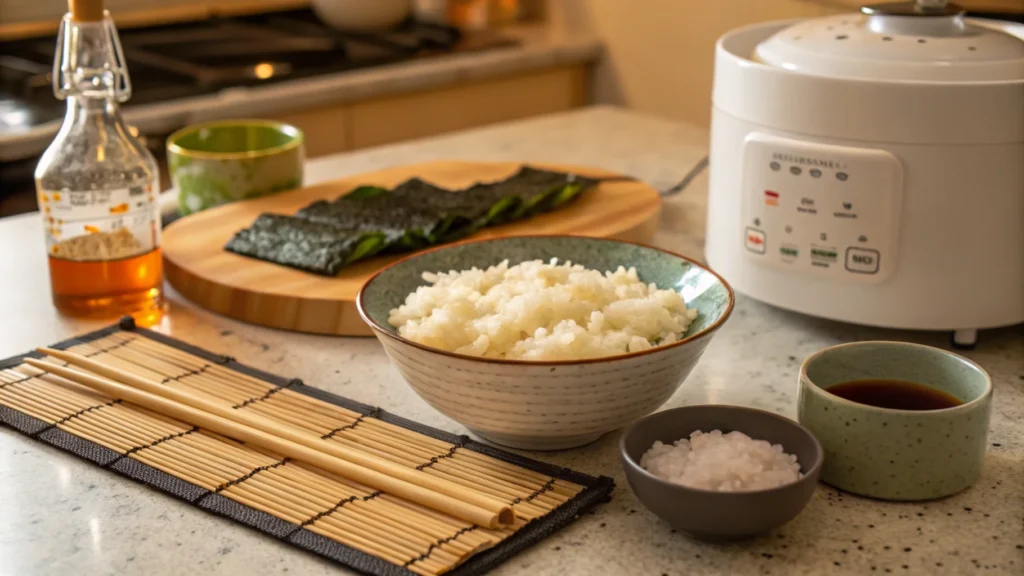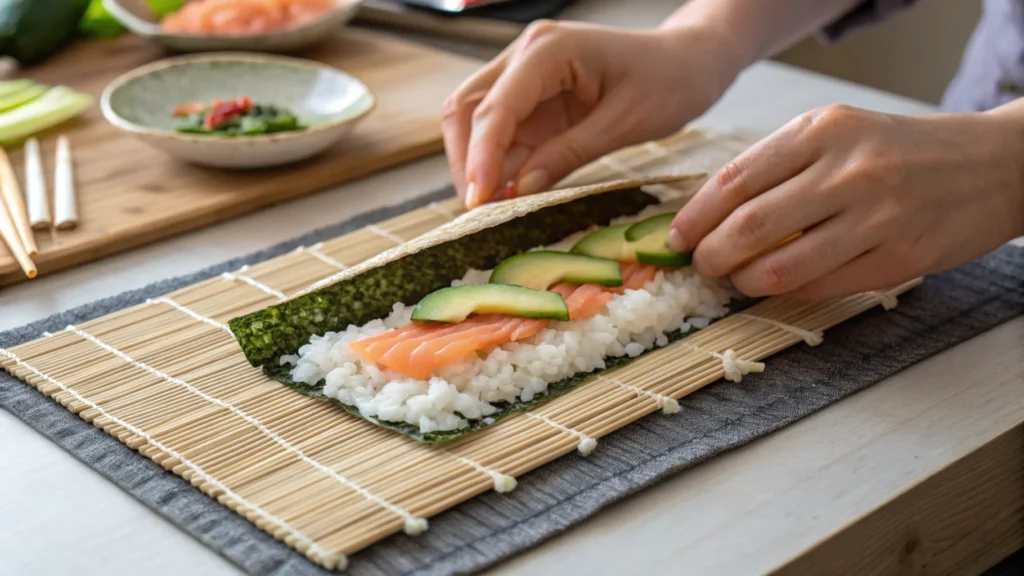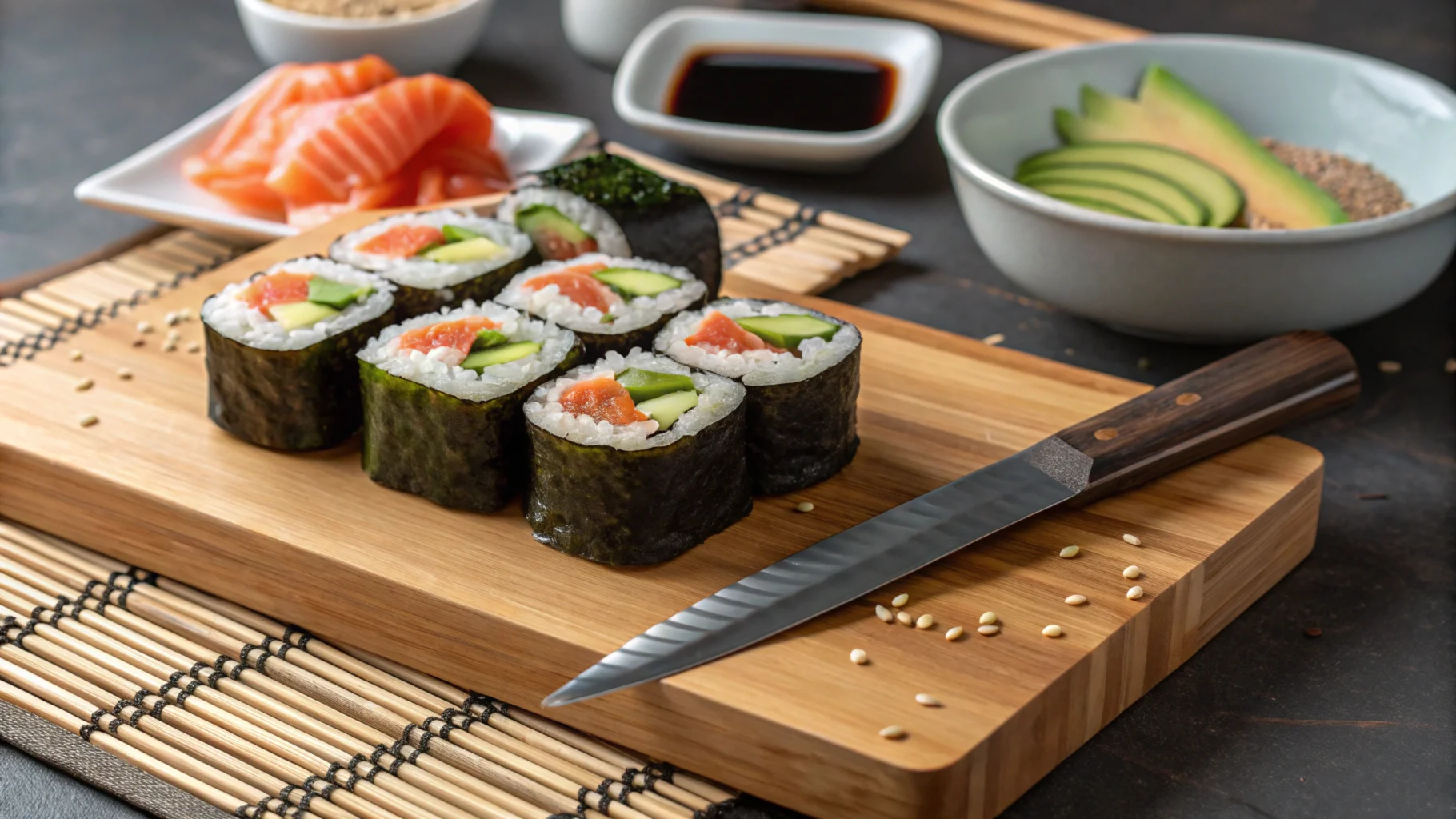How is maki made? Maki rolls, a beloved variety of sushi, are not only delicious but also fun to prepare. For many sushi lovers, learning how to make maki is the first step toward creating their own mouthwatering rolls at home. While sushi may seem intricate, it can actually be quite simple to make once you understand the basics. Whether you’re preparing sushi for a family dinner or impressing guests with your culinary skills, mastering the art of making maki rolls is a rewarding experience. To discover more about the types, ingredients, popular recipes, and health benefits of maki sushi, check out this comprehensive guide to maki sushi.

Table of Contents
Step-by-Step Process to Make Maki
Making maki at home involves several important steps, from preparing the sushi rice to rolling the ingredients into a compact, flavorful bundle. Below, we break down the process so you can easily follow along and achieve great results.
Preparing Sushi Rice
The foundation of any good maki roll is high-quality sushi rice. This sticky, seasoned rice provides the perfect texture and flavor to hold the roll together. Here’s how to prepare it:
- Rinse the Rice: Start by rinsing 1 cup of short-grain Japanese rice under cold water until the water runs clear. This step removes excess starch and ensures the rice won’t become too sticky.
- Cook the Rice: Use a rice cooker or stovetop method to cook the rice. The ratio of rice to water should be 1:1.2, depending on the brand of rice you’re using.
- Season the Rice: Once the rice is cooked, transfer it to a large bowl. While the rice is still hot, season it with a mixture of rice vinegar, sugar, and salt. Let it cool to room temperature before using.
Note: The rice should not be cold when making maki, as it helps the nori adhere better and gives a smoother texture.

Setting Up Your Workspace
To make the process of rolling maki easier, it’s important to have a clean, organized workspace. Follow these steps for smooth preparation:
- Gather Your Ingredients: Make sure you have everything ready before you start. You will need sushi rice, nori (seaweed), fillings (like fish, vegetables, or tofu), and a bamboo sushi mat.
- Prepare Your Tools: Having a sharp knife to cut the rolls and a bowl of water to wet your hands will make the process easier and prevent sticking.
- Create a Clean Surface: Lay a clean kitchen towel or plastic wrap on your workspace to help with rolling and to keep things neat.
By setting up your workspace correctly, you can streamline the process and make it more efficient.
Spreading the Rice
Now that you have your sushi rice ready, it’s time to begin assembling the maki. Spreading the rice evenly over the nori is crucial for the roll’s success. Here’s how to do it:
- Place the Nori on the Mat: Place a sheet of nori on your bamboo sushi mat, with the shiny side facing down.
- Wet Your Hands: Dip your fingers in a bowl of water to prevent the rice from sticking to your hands.
- Spread the Rice: Take a small handful of sushi rice and gently spread it across the nori, leaving about 1 inch of space at the top. Press the rice down evenly to avoid clumps, ensuring it’s thinly and uniformly spread.
Tip: Don’t overfill the nori with rice. A thin, even layer is ideal for making perfect rolls.
Adding Fillings
The fillings are where you can get creative with your maki rolls. You can use a variety of ingredients, but traditional maki rolls often feature fish, vegetables, or even tempura. Here’s how to add the fillings:
- Choose Your Fillings: Common options include fresh fish like tuna or salmon, avocado, cucumber, or pickled vegetables.
- Align the Fillings: Place your chosen fillings along the center of the rice, making sure they’re evenly spaced. Be sure not to overfill the roll, as this can make it difficult to close.
- Layering: If you’re using multiple fillings, layer them one on top of the other for a balanced, flavorful bite in each slice.
Important: Ensure that the fillings are fresh and cut into uniform strips to create a visually appealing and easy-to-roll maki.
Rolling the Maki
Rolling maki can be tricky at first, but with a little practice, you’ll get the hang of it. Here’s how to roll the maki properly:
- Start Rolling: Gently lift the bamboo mat and nori from the bottom, and start rolling it over the fillings, using the mat as a guide. Be sure to roll tightly but not so tight that the ingredients squish out.
- Seal the Roll: Once you’ve reached the exposed edge of the nori, wet it slightly with a little water and press to seal the roll. This ensures the roll stays intact.
- Shape the Roll: After sealing, gently press the roll with your bamboo mat to shape it into a nice, even cylinder.
By rolling evenly, you’ll achieve consistent thickness and the perfect maki texture.

Techniques for Perfect Maki
Mastering the perfect maki roll requires attention to detail and a few essential techniques. Below, we share some tips and tricks for improving your rolling skills and achieving flawless sushi every time.
- Roll with Even Pressure: While rolling, apply even pressure. If you roll too tightly, the ingredients may get crushed. On the other hand, if you roll too loosely, the maki may fall apart.
- Use Fresh Ingredients: Always use the freshest ingredients available. This will not only improve the flavor but also help with the consistency of your rolls.
- Cut Carefully: Use a sharp knife to slice your maki rolls. Make sure to wet the knife with water between cuts to prevent sticking.
- Keep the Nori Dry: Avoid letting the nori sit too long after it’s exposed to moisture from the rice. It can become soggy, making it harder to roll.
With these techniques, your maki rolls will be more consistent, visually appealing, and full of flavor.
Types of Maki Rolls You Can Make
Maki rolls come in a variety of types, each offering a unique flavor and experience. Below are some of the most popular types of maki rolls:
1. Hosomaki
Hosomaki are small rolls that typically contain one filling, such as tuna, salmon, or cucumber. They are perfect for beginners because of their simple construction.
2. Uramaki
Uramaki, or “inside-out rolls,” have the rice on the outside instead of the nori. This type of roll is often filled with a variety of ingredients, such as crab, avocado, and cucumber. They are usually topped with sesame seeds or fish roe.
3. Futomaki
Futomaki are larger rolls with multiple fillings. They are often filled with a combination of fish, vegetables, and pickles. Due to their size, they require a bit more skill to roll, but they are highly satisfying.
4. Temaki
Temaki, or hand rolls, are cone-shaped rolls that are filled with ingredients and eaten with your hands. This style of maki is ideal for those who want a quick, casual sushi experience.
5. Specialty Rolls
These rolls often combine unique ingredients and creative flavor profiles. Some popular specialty rolls include the Dragon Roll, the Rainbow Roll, and the Spider Roll.
By experimenting with different types of rolls, you can expand your sushi repertoire and discover new favorite combinations.
Common Mistakes to Avoid
While making maki can be fun, there are a few common mistakes that many beginners make. Here’s how to avoid them:
- Overfilling the Roll: If you use too many fillings, it can cause the roll to break apart when you try to slice it.
- Not Rolling Tightly Enough: A loose roll won’t hold its shape, making it difficult to cut into clean slices.
- Using Cold Rice: Cold rice doesn’t hold together well and can make the nori harder to work with. Always use room-temperature rice.
- Not Wetting Your Hands: Not wetting your hands while handling the rice can cause it to stick to your fingers and make it difficult to spread.
By being mindful of these common pitfalls, you’ll be able to make maki rolls like a pro.
Health Benefits of Homemade Maki
Homemade maki rolls offer several health benefits compared to store-bought versions. Here are some of the key advantages:
- Control Over Ingredients: When you make your own maki, you can choose fresh, organic ingredients that suit your dietary preferences. For example, you can avoid artificial flavorings or preservatives.
- Rich in Nutrients: Ingredients like fish, vegetables, and seaweed are packed with essential nutrients. Fish is a great source of omega-3 fatty acids, while seaweed is rich in vitamins and minerals.
- Lower in Calories: Homemade maki allows you to control the portion size, making it easier to enjoy a healthy meal without overeating.
Additionally, making your own sushi is a fun way to get the whole family involved in preparing nutritious, tasty meals.
FAQs
What is maki made of?
Maki rolls are a type of sushi made of sushi rice, nori (seaweed), and various fillings. The fillings can include raw fish like salmon or tuna, fresh vegetables such as cucumber, avocado, or even cooked ingredients like tempura shrimp. The rolls originated during the Edo period in Japan and started as street food, perfect for a quick meal. While other types of sushi, like nigiri and sashimi, exist, maki rolls have become a staple in Japanese cuisine and now enjoy global popularity. Modern variations, like the inside-out roll, have also emerged outside Japan, adding fusion twists to the traditional dish.
When was maki made?
Maki rolls, as we know them today, originated in Japan during the Edo period (1603-1868). While sushi itself dates back much earlier, maki rolls became popular in the Edo period as an affordable and easy-to-eat street food. Initially, people wrapped maki rolls in bamboo leaves before nori (seaweed) became the standard wrapping material. During this time, maki rolls became commonly served and enjoyed, especially in Tokyo. Over time, maki has evolved into a global favorite with different variations. If you’re curious about why some foods, like supreme pizza, are universally loved, explore this guide on why supreme pizza is so good.
How to roll maki step by step?
Rolling maki is simple once you get the hang of it. Here’s a step-by-step guide to making perfect maki rolls:
- Prepare sushi rice: Rinse short-grain Japanese rice to remove excess starch, cook it, then season it with a mixture of rice vinegar, sugar, and salt. Let the rice cool to room temperature.
- Set up your workspace: Place a sheet of nori (seaweed) shiny side down on a bamboo sushi mat (makisu).
- Spread the rice: Wet your hands to prevent sticking, then spread a thin, even layer of rice over the nori, leaving about an inch at the top free of rice.
- Add your fillings: Place your fillings—such as raw fish, avocado, or cucumber—along the center of the rice.
- Roll the maki: Start from the bottom of the sushi mat and gently roll the nori and rice over the fillings, using the mat to help you. Keep rolling tightly but not too tight, as it might squish the ingredients.
- Seal and cut: Once you’ve rolled the maki to the top, wet the exposed edge of the nori and press to seal. Use a sharp knife to cut the roll into bite-sized pieces, wiping the knife with water between cuts to keep it clean.
Are Maki rolls from Japan?
Yes, maki rolls are Japanese in origin and are a popular type of sushi. While there are many types of sushi, maki rolls are one of the most well-known varieties, often served at sushi restaurants around the world. The rolls originated during the Edo period in Japan and started as street food, perfect for a quick meal. While other types of sushi, like nigiri and sashimi, exist, maki rolls have become a staple in Japanese cuisine and now enjoy global popularity. Modern variations, like the inside-out roll, have also emerged outside Japan, adding fusion twists to the traditional dish.
Conclusion: How is Maki Made and Why You Should Try It
Making maki at home is an enjoyable and rewarding culinary experience. By following the steps outlined in this guide, you’ll be able to answer the question, “How is maki made?” and create delicious, high-quality rolls right in your kitchen. Whether you opt for simple hosomaki or more elaborate specialty rolls, the key to success lies in preparation, fresh ingredients, and practice. To better understand the nuances between maki and other types of sushi, check out this guide on how maki is different from sushi.
So, gather your ingredients, set up your workspace, and begin making your own delicious maki rolls today.

